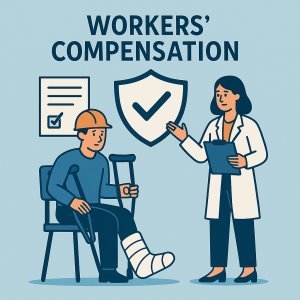In the expanding field of senior companion services, ensuring the safety and well-being of workers is paramount. As professionals tasked with providing essential support to elderly clients, senior companion service workers often face unique occupational hazards that can lead to workplace injuries and subsequent workers’ compensation claims. Understanding the common types of injuries sustained in this sector and implementing effective prevention strategies are critical for minimizing risk, reducing claim costs, and maintaining a productive workforce. This article examines the most frequent workers’ comp claims among senior companion service workers and explores best practices for injury prevention, aiming to support employers, insurers, and workers in fostering safer work environments.
Table of Contents
Senior Companion Service Workers’ Compensation Claims Overview and Industry Trends
Senior companion service workers face a unique set of occupational hazards that contribute to a distinct pattern of workers’ compensation claims. These injuries often stem from the physical demands of assisting elderly clients with mobility, personal care, and daily tasks.The most prevalent injuries include musculoskeletal strains, such as back injuries and repetitive strain injuries, caused by lifting or supporting clients. Slip-and-fall incidents and minor accidents related to navigating diverse home environments are also commonly reported, along with occasional bruises and cuts incurred during caregiving duties.
Preventative strategies prioritizing both worker safety and client well-being have become increasingly essential. Employers are investing in training programs focused on proper body mechanics and the use of assistive devices to reduce strain injuries. Additionally, ergonomic interventions and scheduled breaks are proving effective in minimizing repetitive stress.below is a table summarizing typical injury types alongside key prevention approaches.
| Injury Type |
Common Causes |
Prevention Strategies |
| Musculoskeletal Strains |
Lifting, transferring clients |
Proper training, ergonomic equipment |
| Slips and Falls |
Uneven surfaces, cluttered spaces |
Environmental assessments, slip-resistant footwear |
| Repetitive Stress Injuries |
Repeated motions, poor posture |
Scheduled breaks, ergonomic adjustments |
| Minor Cuts and Bruises |
Handling aids, client movement |
Use of protective gear, cautious handling |
Identifying the Most Common Injuries Among Senior Companion Workers
Senior companion workers frequently face physical challenges that increase thier risk of injury during daily duties. Musculoskeletal strains, notably affecting the back, shoulders, and wrists, are among the most common due to repetitive lifting, assisting with mobility, and prolonged periods of standing or bending. Additionally, slips, trips, and falls represent a critically important hazard in home environments where clutter or uneven flooring can pose unexpected risks. Another notable injury is tendinitis, often caused by repetitive motions like helping clients with personal care or household tasks.
Occupational stress and fatigue also contribute indirectly to workplace injuries by diminishing alertness and coordination. To illustrate the typical injury occurrences, the following table highlights the predominant injury types and their estimated frequency based on recent workers’ comp claim data:
| Injury Type |
Estimated Frequency |
Common Cause |
| Back Strain |
42% |
Assisting with patient mobility |
| Slips and Falls |
25% |
Uneven or cluttered home surfaces |
| Wrist Tendinitis |
15% |
repetitive lifting and patient handling |
| Shoulder Injuries |
12% |
Overhead reaching and lifting |
| Fatigue-related Incidents |
6% |
extended work hours and stress |
- Proactive ergonomics training can substantially reduce incidence rates.
- Environmental assessments help identify and mitigate fall hazards.
- Proper use of assistive devices minimizes strain on vulnerable body parts.
Risk Factors Contributing to Workplace Injuries in Senior Companion Services
Senior companion workers often face unique challenges that increase their susceptibility to workplace injuries. One primary factor is the physical demand of assisting elderly clients with mobility,including lifting,transferring,and support activities,which can lead to musculoskeletal disorders such as strains and sprains. Additionally, the variability of home environments-ranging from cluttered spaces to uneven flooring-creates more opportunities for slips, trips, and falls. Complicating these risks is the unpredictable nature of client behavior, particularly when cognitive impairments like dementia or Alzheimer’s disease are involved, which can result in sudden movements or resistance during care.
other contributing elements include extended work hours without adequate breaks, resulting in fatigue that diminishes alertness and increases error likelihood. Lack of proper ergonomic training and insufficient use of assistive devices further exacerbate the risk profile for these workers. Below is a rapid breakdown of common risk factors observed in senior companion services:
- Physical strain: Frequent lifting and supporting clients
- Environmental Hazards: Poorly maintained or cluttered home settings
- Client Behavior: Challenging interactions due to cognitive impairments
- Fatigue: Long shifts and inadequate rest periods
- Training Gaps: Limited ergonomic and safety education
Effective Strategies and Best Practices for Injury Prevention and Safety Compliance
Implementing proactive measures is crucial in reducing work-related injuries among senior companion service workers. prioritizing ergonomic training helps caregivers maintain proper posture and body mechanics when assisting clients, substantially decreasing the risk of strains and sprains.Additionally, fostering a culture of open communication encourages employees to report hazards or early signs of injury without fear of reprisal, enabling swift intervention. Regular safety audits and refresher courses on safe lifting techniques and emergency protocols further empower staff to handle daily tasks with confidence and care.
Key best practices include:
- Mandatory use of assistive devices such as gait belts and transfer boards
- Scheduled breaks to prevent fatigue-related accidents
- Comprehensive incident reporting system for immediate response
- Routine workplace hazard assessments
| Strategy |
Benefit |
Implementation Tip |
| Ergonomic Training |
Reduces musculoskeletal injuries |
Incorporate hands-on workshops quarterly |
| Assistive Device Usage |
Prevents lifting-related injuries |
Ensure availability and routine checks |
| Open Communication |
Early hazard detection |
Establish anonymous reporting channels |
| Routine Safety Audits |
Identify risks before incidents occur |
Assign dedicated safety officers |
Q&A
Q&A: Senior Companion Service Workers’ Comp Claims: Common injuries and Prevention
Q1: What are the most common types of workers’ compensation claims filed by senior companion service workers?
A1: Senior companion service workers most frequently file workers’ compensation claims related to musculoskeletal injuries, such as strains and sprains from lifting or assisting clients. Other common injuries include slips, trips, and falls, as well as repetitive motion injuries and occasional incidents of back injuries. These claims often result from the physical demands of the job and environmental hazards in clients’ homes.
Q2: Why are senior companion workers particularly susceptible to these types of injuries?
A2: The role of a senior companion often involves providing physical assistance to elderly clients, such as helping with mobility, transferring from beds or chairs, and performing light housekeeping. These activities require frequent bending, lifting, and balancing, which can strain muscles and joints. Additionally, workers often operate in varied and sometimes unsafe home environments lacking proper ergonomic support or safety measures.
Q3: How do workers’ compensation claims impact senior companion service agencies?
A3: Workers’ compensation claims can have significant financial and operational impacts on senior companion service providers. High claim rates may lead to increased insurance premiums and possibly strained resources to manage claims and implement corrective measures. Additionally, injury-related absences can disrupt continuity of care for clients and reduce overall service quality.
Q4: What preventive measures can senior companion agencies implement to reduce injury risks?
A4: Agencies should invest in comprehensive training programs focused on safe client handling techniques, ergonomics, and hazard recognition. Providing proper assistive equipment, encouraging use of personal protective equipment (PPE), and conducting regular safety audits of client environments are also critical. Furthermore, fostering a culture of safety by encouraging early reporting of hazards and minor injuries can prevent more serious incidents.
Q5: How important is ongoing education and training in reducing workers’ comp claims among senior companions?
A5: Ongoing education is essential in minimizing injury risks. Regularly updated training ensures that workers stay informed about best practices for safe client handling and workplace ergonomics.Continuous reinforcement helps maintain worker awareness, reduces complacency, and ultimately lowers the occurrence of preventable injuries.
Q6: Can technology play a role in preventing injuries among senior companion workers?
A6: Yes, technology can significantly aid in injury prevention. Such as, mobile apps and wearable devices can provide real-time guidance on proper lifting techniques or alert workers to hazardous conditions.Additionally, digital scheduling tools can optimize workloads to prevent fatigue-related injuries, while electronic documentation can streamline incident reporting and response.
Q7: What steps should agencies take if a senior companion worker is injured on the job?
A7: Immediate response includes ensuring the injured worker receives appropriate medical attention and documenting the incident thoroughly. Agencies should report the injury to their workers’ compensation carrier promptly and cooperate throughout the claims process. Following an injury, conducting a root cause analysis to identify and correct contributing factors is crucial to prevent recurrence.
Q8: How can agencies balance the need for comprehensive care with injury prevention for senior companions?
A8: Balancing care quality with worker safety requires strategic planning. Agencies must prioritize safety protocols without compromising client support by employing team-based approaches for physically demanding tasks and integrating assistive technology. Clear communication channels between staff, clients, and supervisors facilitate adjustments when necessary to maintain both safety and service excellence.
This Q&A aims to inform senior companion service providers and stakeholders about common workers’ compensation claims, associated risks, and practical prevention strategies, ultimately promoting a safer and more effective care surroundings.
In Summary
senior companion service workers face unique risks that can lead to workers’ compensation claims, with common injuries often stemming from physical strain, slips, trips, and falls.By understanding these hazards and implementing proactive prevention strategies-such as proper training, ergonomics, and workplace safety measures-employers can not only mitigate injury risks but also foster a safer, more supportive environment for their caregivers.Prioritizing injury prevention ultimately benefits both the workforce and the seniors they serve, driving improved outcomes and operational efficiency in this vital sector.
“This content was generated with the assistance of artificial intelligence. While we strive for accuracy, AI-generated content may not always reflect the most current information or professional advice. Users are encouraged to independently verify critical information and, where appropriate, consult with qualified professionals, lawyers, state statutes and regulations & NCCI rules & manuals before making decisions based on this content.








